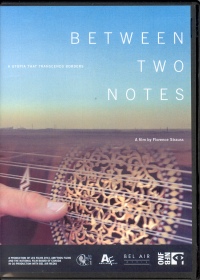| ________________
CM . . .
. Volume XIV Number 21. . . .June 13, 2008 
 |
Between Two Notes: A Utopia That Transcends Borders.
Florence Strauss (Director). Serge Lalou (Les Films d'Ici Producer). Amit Breuer (Amythos Films Producer). Colette Loumède (NFB Producer). François Duplat (Bel Air Media Producer).
Montreal, PQ: National Film Board of Canada, 2006.
84 min., 44 sec., VHS or DVD, $99.95.
Order Number: 153E 9907 160.
Professional.
Review by Frank Loreto.
*** /4
|
| |
|

excerpt:
The world is divided in half-east and west-the halves weep. They long for each other.
Music is often seen as a common language-one in which all cultures and traditions can share ideas and make connections. While this is the thesis of Between Two Notes, the film seems to undermine this message by showing that, although the music may have common elements; those playing or listening to it are not fully open to its value. Entitled Les Blues d'Orient in its French version, Between Two Notes showcases a wide variety of eastern music, but it also presents a feeling of sadness that there is a division at all.
This is a film filled with performances and discussions of the various forms of eastern music. Clearly there is no one kind as the film shows that there is great diversity even within a small geographic area. The first musicians presented are Iraqi Jews who now live in Israel. The music they play is Arabic and comes from a culture that is over 2500 years old. This music is their way of keeping their lost culture alive. However, they know that an Israeli audience will not listen to it as it is Arabic - even if it actually a Hebrew-Arabic mix. One speaker admits that the music is difficult to listen to at first as the songs are long and sound repetitive to the untrained ear. Actually, he states, there are subtle variations, and the music is worth the effort. English translations of the songs are provided in subtitles.
This music should be a connector to the various cultures as all musics of the area could be seen to have a common link. As the Nile River annually flooded its banks, that set the pace for Egyptian life for centuries. Now, however, the Nile no longer floods, and that pace seems to have stopped. The music which was a similar pace of life also seems to have stopped. But this should not be so. Coptic chants can trace their origins to the music used in ceremonies of the pharaohs. The Israelites lived under the pharaohs and were influenced by Egyptian culture. The music of the pharaohs and Hebrews were mixed together. Some songs sung in the synagogue are Arabic, but have been changed, sometimes only in the punctuation. The statement is made that "all music in the Middle East comes from a liturgical milieu because the music is serious."
The world has changed. Aleppo, once a hub of caravan traffic, was a place where many cultures would mix and share music. Now the caravans are gone, and Aleppo is no longer a hub and cultures are not as willing to mix.
Between Two Notes moves to Lebanon where a speaker there says, "I don't know when we learned music. It is everywhere. It affects the marrow of the bone." He recounts how he went to Paris to study music, but when he returned home he found that his instrument, the 3 valve trumpet, was unable to play the music of his heritage. He had to modify the instrument, but he also became aware of the division between east and western music. He adds to the history of eastern music, pointing to Andalusia in Spain where all religions and cultures worked in harmony and music was shared by all - Arabs, Berbers and Visigoths, Jews, Christians and Muslims. That, too, ended, and the sharing stopped.
One speaker bemoans the loss of Aramaic which was a bridge between Arabic and Hebrew. That bridge is gone as Aramaic is now a forgotten language. The Arabs in Israel know Hebrew, but the Israelis do not know Arabic. "Because of the conflict, Arabic is the language of the enemy. How can you learn the culture when you only see it through the rifle sights?"
And that is where the "blues" aspect of the film is evident. There is a richness here and great potential for common ground. However, that probably will not be realized. The Jewish Iraqi musicians admit that when they no longer play their music; Arab musicians will be the ones to continue.
This is a powerful film. As stated earlier, there is a great deal of music. Instruments not used in western music are played with great skill. However, the film is not something that students would sit through. It is long, and the history referred to in the film is not something the students would know. A fair bit of preparation would be necessary before viewing. For music teachers, though, this film is a gold mine of information and is worthwhile viewing. For schools with an Arabic population, this film could provide the starting ground for interesting discussion.
As I write this, I am listening to Anuoar Brahem from Tunisia. He is not featured in the film, but I found his music while searching for one of the artists presented in the film. There is an exciting world of music with much to explore here!
Recommended.
Frank Loreto is a teacher-librarian at St. Thomas Aquinas Secondary School in Brampton, ON.

To comment
on this title or this review, send mail to cm@umanitoba.ca.
Copyright © the Manitoba Library Association. Reproduction for personal
use is permitted only if this copyright notice is maintained. Any
other reproduction is prohibited without permission.
NEXT REVIEW |
TABLE OF CONTENTS FOR THIS ISSUE
- June 13, 2008.
AUTHORS |
TITLES |
MEDIA REVIEWS |
PROFILES |
BACK ISSUES |
SEARCH |
CMARCHIVE |
HOME |
